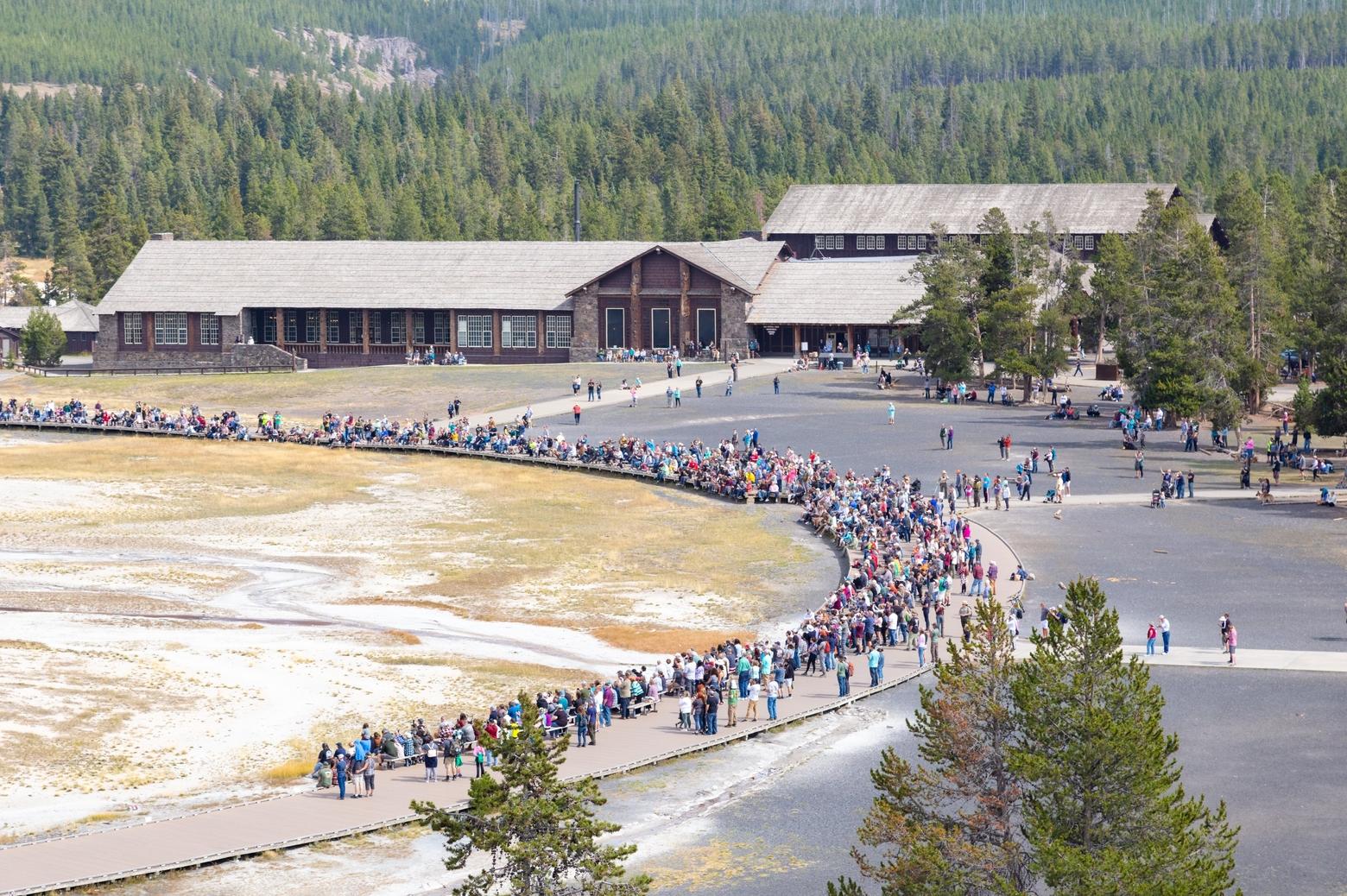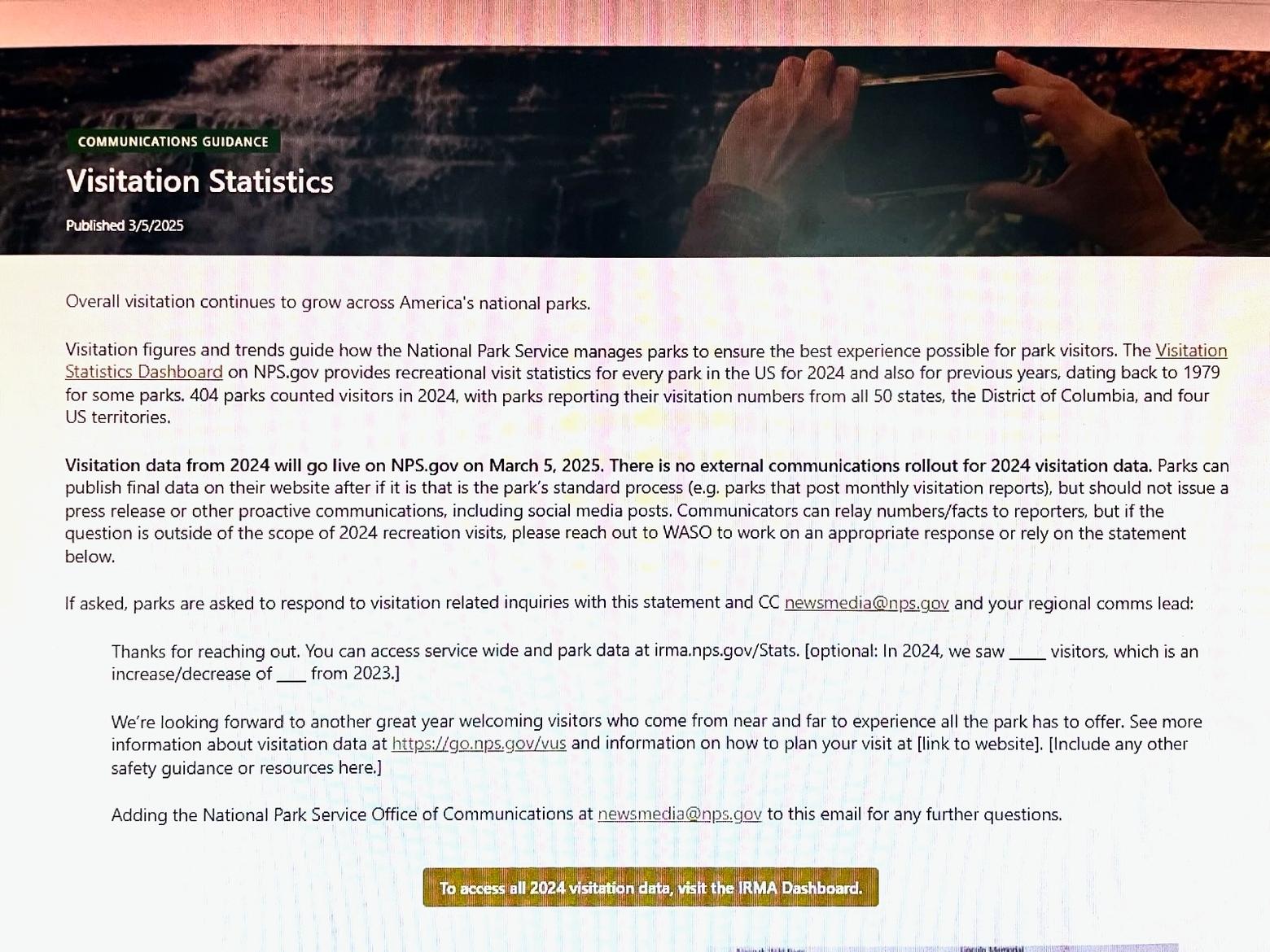Back to StoriesTrump Administration Bars NPS from Reporting Visitor Data
April 1, 2025
Trump Administration Bars NPS from Reporting Visitor DataAs national parks gear up for busy tourist season, muted visitor data leaves experts ‘shocked.’
CORRECTION: An earlier version of this story incorrectly quoted Kelly Pohl as saying West Yellowstone had "about 11,000 people." The correct population of West is approximately 1,100.
by Robert Chaney
Yellowstone National Park welcomed 250,000 more visitors in 2024 than it did in 2023. What’s the significance?
Don’t ask the National Park Service.
While the previous year’s visitation report is routinely released in early March, national park communications offices have reportedly been told not to publicize them or discuss them in detail if asked. A request for comment from the NPS national media office was not returned as of Tuesday.
An internal March 5 Park Service memo obtained by SF Gate starts with the observation that “overall visitation continues to grow across America’s national parks.”
But after mentioning that 2024 visitation data will go live that same day, the memo states NPS staff “should not issue a press release or other proactive communications, including social media posts. Communicators can relay numbers/facts to reporters, but if the question is outside the scope of 2024 recreation visits, please reach out to WASO [Washington Support Office] to work on an appropriate response.”
“I’m so shocked to see it happening,” said Melanie Walsh, an assistant professor at the University of Washington’s Information School who teaches in the Responsible Datasets in Context project. “Collecting data is powerful, even when it’s approximate and imperfect. Visitation data demonstrates how many people love national parks and use national parks. It’s a way to advocate for communities we love and want to protect. Apparently, the Trump administration doesn’t want people to know how much engagement citizens have with national parks.”
For the record, Yellowstone continued its climbing trend in 2024, with 4.7 million visitors. 2023 logged 4.5 million and 2022 had 3.2 million. 2021 remains the record-holder, when the Covid pandemic drove 4.8 million people crazy for outdoor relief in the nation’s oldest national park.
Grand Teton National Park posted a similar trend, with 2024’s 3.6 million visitors exceeding 2023 and 2022, but not the record 2021’s 3.8 million. Glacier National Park topped 3 million visitors for the fourth time, posting 3.2 million in 2024. It also hit 3 million in 2021 and 2019, and 3.3 million in 2017.
All three parks show a noticeable leveling-up around 2015. Glacier in particular lurched from around 2 million visitors through the first decade of the 21st century to 2.9 million in 2016. That 45 percent increase has huge significance for both park internal management and the fate of surrounding communities.
“The impact is hard to overstate,” said Kelly Pohl of Headwaters Economics. “Look at West Yellowstone. It’s a town of about 1,100 people that hosts 4 million visitors a year. That puts tremendous pressure on its road system, its wastewater treatment. It needs to know what trends look like, so it knows what changes to consider in infrastructure and development plans.”
The National Park Service spends about $3.3 billion a year to take care of 63 parks and 370 other historic sites, battlefields and significant landmarks. It typically employs about 20,000 full-time and seasonal employees.
In February, President Trump’s DOGE office fired about 1,000 of those workers who had probationary status, including many who were career staff that had recently received promotions or transfers. Another 700 resigned or accepted buy-outs through the “Fork in the Road” offer.
“Look at West Yellowstone. It’s a town of about 1,100 people that hosts 4 million visitors a year." – Kelly Pohl, Associate Director, Headwaters Economics
The D.C.-based publication Roll Call reported on March 11 that staff-cut impacts have already materialized across the national park system, including traffic backlogs at entrance gates, reduced hours at visitor centers, smaller maintenance crews and canceled ranger tours. While several mid-March court orders resulted in rehiring most of those terminated workers, their status remained in limbo as the Trump administration appealed the reversal.
During an appearance in Bozeman March 7, Sen. Steve Daines, R-Montana, said seven Yellowstone National Park probationary employees had been fired and another 13 were believed to have resigned through the DOGE’s Fork in the Road portal. He added that it was possible some of those fired workers would be rehired.
Daines also described concerns about reductions of NPS services as “a little bit of a tempest in a teapot,” telling the Bozeman Daily Chronicle, “If you were to listen to the news right now, what you all have written and published, you’d think that Yellowstone Park is not going to make it.”
Rep. Ryan Zinke had similar comments during a March 14 visit to Kalispell.
“Seasonal hiring is proceeding and Glacier [National Park] leadership is confident that as long as Senate Democrats do not shut down the federal government then the park hiring and plowing will progress on schedule,” Zinke said in a March 14 press release. “While two probationary employees were laid off, [Glacier] has a plan moving forward to ensure the world class experience that Montanans and visitors seek will remain intact.”
Zinke also blamed the Biden administration for reclassifying thousands of long-term Forest Service seasonal workers as probationary employees, which got them swept up in the DOGE firings.
“The recent ruling to bring back those employees creates an opportunity for DOGE to set their sights on the real waste – the overpaid lawyers, biologists and environmental zealots and the top-heavy bureaucracy,” Zinke said in a statement. “The guys and gals on the frontlines maintaining trails, harvesting trees, and supporting fire camps are seasonal and should be classified as such as they always had been before Biden changed it.”
Both Daines and Zinke supported the Explore Act in 2024 (HR 6492), which was signed into law last year. It included a goal of “creating new pilot programs to monitor visitation.”
“That was a bipartisan call for better data on land-management decisions,” Pohl said. “This latest memo is confusing in light of that bipartisan support.”
Neither Daines or Zinke returned requests seeking comment.
__________________________________________________________________________________________________
Mountain Journal is a nonprofit, public-interest journalism organization dedicated to covering the wildlife and wild lands of Greater Yellowstone. We take pride in our work, yet to keep bold, independent journalism free, we need your support. Please donate here. Thank you.
Related Stories
March 21, 2025
How Deep Does It Go? Future of Area Water Monitoring in Question
With USGS offices in Greater Yellowstone among dozens of regional government buildings on the chopping block, DOGE savings efforts leave anglers...
May 23, 2025
Critiquing the Emperor in Grizzly Country
Biologist David Mattson remembered for career of iconoclastic science on predators.
November 7, 2023
A Piece of the Conservation Puzzle
Missouri Headwaters Conservation
Area could provide an additional tool for private landowners and protect 250,000 acres from subdivision and sprawl.





